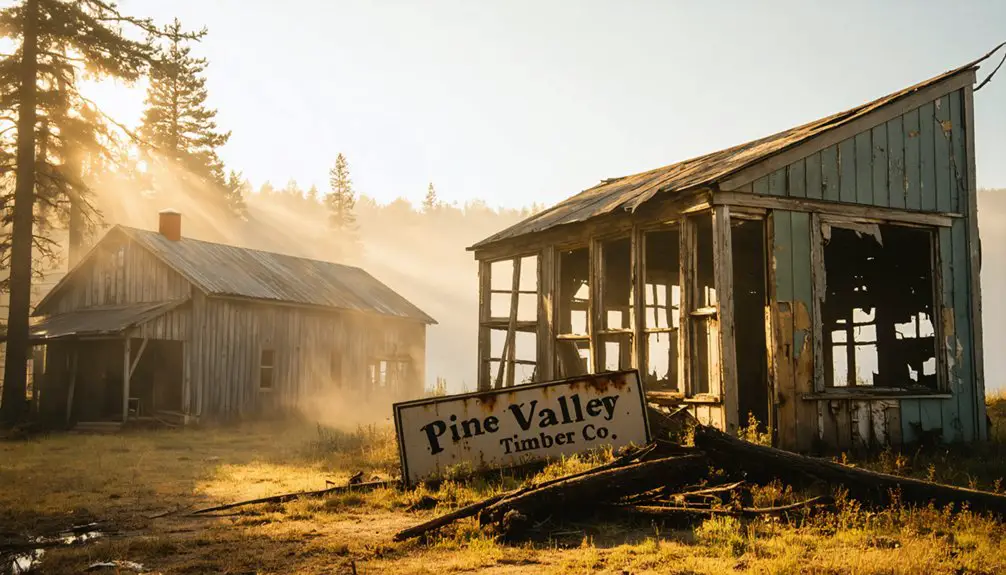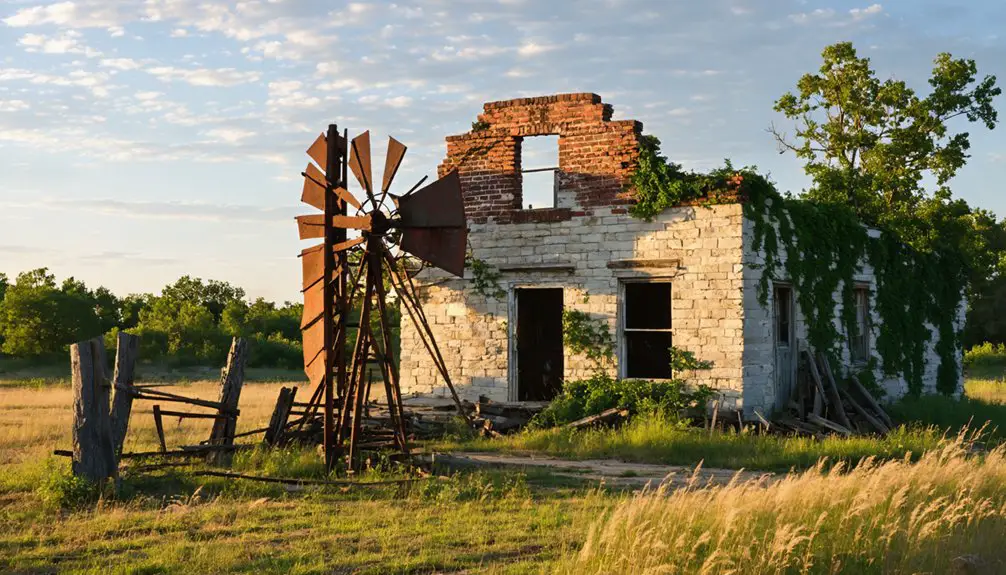You’ll discover Pine Valley’s haunting remnants in Le Flore County, Oklahoma, where a bustling lumber settlement of 1,500 residents once thrived. Founded in 1927 by the Dierks brothers, this company town boasted hotels, churches, and a movie house, all supported by a double-band sawmill operation. The Great Depression, followed by timber depletion and the railroad’s closure in 1942, transformed this industrial powerhouse into abandoned ruins. Today’s scattered foundations and weathered railway ties tell a deeper story of boom-and-bust in America’s heartland.
Key Takeaways
- Pine Valley was a thriving lumber company town established in 1927 in Le Flore County, Oklahoma, reaching a peak population of 1,500 residents.
- The town featured essential infrastructure including hotels, a movie house, churches, an ice plant, and a double-band sawmill operation.
- Economic decline began during the Great Depression, with timber depletion and railroad closure in 1942 leading to the town’s abandonment.
- The settlement was founded by the Dierks brothers as part of their 1.75-million-acre timber empire in southeastern Oklahoma.
- Today, scattered ruins of mill buildings, housing foundations, and old railroad remnants mark Pine Valley’s location as a ghost town.
From Lumber Dreams to Ghost Town Reality

When Pine Valley emerged in Le Flore County, Oklahoma in 1927, it represented the ambitious vision of a permanent lumber settlement rather than the temporary camps that had dominated the industry.
You’d have found a thriving hub of over 1,500 residents supported by a double-band sawmill operation that showcased the region’s lumber legacy. The town’s impressive infrastructure included everything from a hotel and movie house to churches and an ice plant.
Pine Valley hummed with sawmill activity, its 1,500 residents enjoying modern amenities from hotels to ice plants in this lumber boomtown.
Founded by the visionaries Hans, Herman, Peter, and Henry, the Dierks brothers established their company in the 1880s before expanding into Oklahoma. Despite the community resilience shown through its schools, healthcare facilities, and diverse amenities, Pine Valley’s fate was tied to timber. The Dierks Lumber Company faced severe financial struggles during the Great Depression, impacting the town’s stability.
As resources depleted and industry economics shifted post-1940s, the once-bustling company town couldn’t sustain itself. The Oklahoma & Rich Mountain Railroad that had been its lifeline fell silent, and Pine Valley’s dream of permanence faded into ghost town reality.
The Dierks Brothers’ Industrial Vision
You’ll find the Dierks brothers’ strategic vision exemplified in their establishment of Pine Valley as part of their vast 1.75-million-acre timber empire across Arkansas and Oklahoma.
Their innovative approach included building extensive railroad networks, like the DeQueen and Eastern Railroad, to efficiently transport lumber and even entire mobile towns to new logging sites.
The brothers’ industrial planning went beyond mere timber harvesting, as they created fully equipped company towns with ample amenities, while simultaneously pioneering sustainable forestry practices in the 1920s to guarantee long-term resource viability.
The Broken Bow sawmill grew to become one of the largest lumber processing facilities in the United States, showcasing the scale of their operations.
A key part of their transportation infrastructure included locomotive 206, a 2-6-2 Alco engine that served their Pine Valley operations.
Strategic Lumber Empire Development
The Dierks brothers transformed a modest Nebraska lumber business into a formidable Southern timber empire through strategic expansion and innovative industrial practices.
You’ll see their genius in how they steadily acquired over 1.2 million acres across Oklahoma and Arkansas by the early 1900s, securing vast timber resources that would fuel their ambitious plans.
They revolutionized lumber production by establishing mechanized mills like Pine Valley and Mountain Pine, equipped with double-band saws that could process hundreds of thousands of board feet daily.
Under the leadership of Peter Dierks, the company survived the Great Depression and emerged debt-free by 1938.
They ditched old-fashioned mule teams for modern rail transport and pioneered sustainable forestry practices when most competitors still used cut-and-run methods.
The brothers demonstrated their industrial vision by building the Texas, Oklahoma and Eastern Railroad to efficiently transport lumber from their mills to market.
Railroad Transportation Network Implementation
Building upon their innovative mill operations, the Dierks brothers engineered an ambitious railroad network that would become the backbone of their expanding timber empire.
You’ll find their rail network began with the 1903 chartering of the De Queen and Eastern Railroad, followed by the Texas, Oklahoma and Eastern Railroad in 1910, which connected Valliant to Broken Bow and later De Queen.
They didn’t stop there – they constructed a 33-mile private line between Wright City and Clebit for dedicated timber transport.
The rails enabled the creation of company towns like Pine Valley, where entire buildings could be moved by rail to support logging operations. By 1930, the brothers had established over twenty retail yards across their territory. The Oklahoma and Rich Mountain Railroad served the area until timber resources depleted in 1942.
Regional Economic Growth Vision
Driven by an ambitious vision of regional economic development, Dierks brothers established Pine Valley in 1927 as one of the American South’s largest mill towns, integrating lumber production with extensive community planning.
You’ll find their vision reflected in the creation of self-sustaining industrial communities, where economic sustainability meant investing in thorough infrastructure – from housing and schools to medical facilities and commercial outlets.
The brothers’ commitment to community resilience went beyond basic amenities. They revolutionized their approach by abandoning the “cut and get out” logging model, implementing selective cutting methods and fire protection systems to guarantee long-term resource viability.
While this initially reduced profits, it established the foundation for sustained economic growth, transforming Pine Valley into a thriving hub that supported both industrial operations and regional development. The town’s population reached its peak of around 1,500 residents between 1928 and 1940, demonstrating the success of their economic vision.
Life in a Segregated Company Town
As one of the largest lumber towns in the American South, Pine Valley exemplified the stark reality of segregated company towns in the 1920s and 30s.
You’d find a town divided by strict racial lines, with African American workers confined to designated residential areas separate from white residents. The racial dynamics affected every aspect of daily life, from where you could live to where you could worship.
While the town boasted modern amenities like a hotel, movie house, and ice plant, segregated living meant African American residents faced restricted access and inferior facilities. The town was established in 1927 as a lumber town and quickly became a major center for timber processing.
Despite Pine Valley’s modern features, racial segregation forced Black residents to endure second-rate facilities and limited access to amenities.
You couldn’t escape the company’s control – they owned the stores where you shopped, the house you lived in, and deducted expenses directly from your wages. For Black workers, this meant primarily labor-intensive jobs with limited opportunities for advancement.
Railroad’s Role in Pine Valley’s Rise and Fall

When you track Pine Valley’s history, you’ll find the Oklahoma & Rich Mountain Railroad‘s 1925 establishment was the lifeline that transformed this remote area into a bustling company town of 1,500 residents.
The railroad’s 17-mile connection to Page enabled the Pine Valley Lumber Company to efficiently transport timber and workers while establishing essential town amenities like a hotel, general store, and school.
As the region’s timber resources were exhausted by the early 1940s, the railroad’s closure in 1942 severed Pine Valley’s economic artery, quickly reducing this once-thriving mill town to a ghost town.
Railroad Fuels Town Growth
The Oklahoma & Rich Mountain Railroad‘s arrival in 1926 transformed Pine Valley from wilderness into a bustling lumber town of 1,500 residents.
The railroad expansion brought by the O&RM provided vital economic infrastructure that connected Pine Valley to regional markets, enabling Dierks Lumber Company to thrive.
You’d have seen a flurry of development as the railroad’s presence spurred construction of extensive town facilities. The rail line allowed Dierks to build a complete community, including a hotel, stores, churches, and over 100 homes.
The railroad’s 17-mile route from Page made it possible to efficiently transport massive quantities of timber, attracting workers and businesses. This transportation artery proved essential for Pine Valley’s success, linking the town’s lumber operations to the broader network of southeastern Oklahoma’s growing rail system.
Tracks to Ghost Town
Once a lifeline for Pine Valley’s bustling lumber economy, the Oklahoma & Rich Mountain Railroad’s 1942 abandonment marked the town’s swift descent into ghost town status.
You’ll find that as timber resources depleted and freight traffic dwindled, the 17-mile rail line connecting Page to Pine Valley could no longer sustain operations.
Today’s ghost town explorers can trace the old right-of-way through Rich Mountain’s winding terrain, where railroad nostalgia mingles with remnants of a once-thriving company town.
While neighboring Muse survived, Pine Valley couldn’t endure without its railroad lifeline. The town’s population of 1,500 quickly dispersed after losing both rail service and lumber operations.
What remains are silent reminders of how closely Pine Valley’s fate was tied to those steel rails.
The Great Depression’s Impact on Local Economy
During America’s darkest economic period, Pine Valley’s local economy crumbled under the weight of Oklahoma’s devastating 25% unemployment rate and widespread bank failures.
You’d have witnessed unprecedented economic hardship as over 200 banks collapsed between 1929 and 1933, wiping out your neighbors’ life savings. The petroleum industry’s crash following the East Texas oil discovery left countless workers jobless, while local farmers watched helplessly as crop prices plummeted – cotton falling from 16 to 6 cents per pound, wheat from $1 to just 38 cents per bushel.
Despite the community’s resilience, Pine Valley’s residents joined the masses at soup kitchens and bread lines. Many families abandoned their homes, joining the “Okie” migration in search of work, leaving behind empty buildings and broken dreams.
Modern Day Remnants and Historical Significance

Located between Page and Muse, Oklahoma, visible remnants of Pine Valley’s industrial past still dot the landscape, where you’ll find scattered ruins of mill buildings and housing foundations from what was once a bustling lumber town of 1,500 residents.
You can trace portions of the original Oklahoma & Rich Mountain Railroad right-of-way, which served as Pine Valley’s lifeline from 1926 to 1942. While today’s regrown forests have reclaimed much of the area, fragments of historical preservation remain, including weathered railway ties and occasional signage that mark this important piece of community heritage.
The town’s infrastructure once boasted everything from a movie theater to multiple churches, reflecting its significance as one of southeastern Oklahoma’s largest lumber communities during the early 20th century.
Frequently Asked Questions
What Happened to the Original Buildings and Houses After Pine Valley’s Abandonment?
Ever wonder what time does to abandoned places? You’ll find Pine Valley’s buildings weren’t preserved as historical landmarks – they’ve deteriorated naturally through weathering, collapsed from neglect, and some materials were scavenged by locals.
Were There Any Notable Crimes or Incidents in Pine Valley’s Jail?
You won’t find specific records of notable incidents in the jail, as documentation about crime rates and jail conditions remains scarce. Most infractions likely involved minor offenses like drunkenness or labor disputes.
Did Any Former Pine Valley Residents Establish Successful Businesses Elsewhere?
You won’t find documented business migrations or entrepreneurial successes from Pine Valley residents. While some may have integrated into nearby towns’ economies, there’s no specific record of their business ventures elsewhere.
What Was the Average Salary of Lumber Mill Workers?
You’d find average wages in the Southern lumber industry ranged from $1.50-$3 daily for common laborers and $3-$5+ for skilled workers, with additional value from company-provided housing and amenities.
How Did Pine Valley’s Education System Compare to Other Oklahoma Towns?
Like a well-oiled lumber mill, Pine Valley’s segregated school matched typical educational achievements and school demographics you’d find in other Oklahoma towns, offering basic education until the Depression caused decline.
References
- https://en.wikipedia.org/wiki/Oklahoma_&_Rich_Mountain_Railroad
- https://www.okhistory.org/publications/enc/entry?entry=GH002
- https://www.okhistory.org/publications/enc/entry?entry=MI028
- https://www.frrandp.com/2020/07/pine-valley-and-oklahoma-rich-mountain.html
- https://jp.pinterest.com/pin/logging-in-2024–928445279422362713/
- https://www.arkansasheritage.com/arkansas-register/dierks-lumber-company-building
- https://www.okhistory.org/publications/enc/entry?entry=FO024
- https://discover.hubpages.com/travel/The-Forgotten-Town-of-Pine-Valley
- https://gateway.okhistory.org/ark:/67531/metadc2299591/
- https://en.wikipedia.org/wiki/Dierks_Forests



